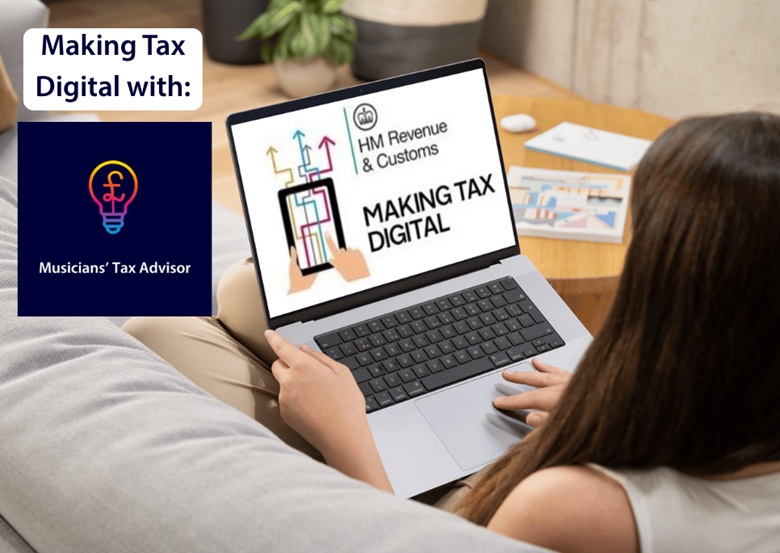What Making Tax Digital means for self-employed musicians
Florence Lockheart
Friday, April 4, 2025
The government’s Making Tax Digital initiative is intended to ‘modernise’ the tax system, but what does the change mean for self-employed musicians when it comes to income tax? Tax advisor Sinead Pratschke offers her guide

Making Tax Digital (MTD) is part of the government’s strategy to modernise the UK tax system and close the tax gap. With the Income Tax element now firmly on the horizon for sole traders and landlords, what do Self Employed Musicians need to know?
Key Elements of Making Tax Digital for Income Tax (MTD-ITSA)
- You will be required to maintain digital business records and use compatible software to submit tax information to HMRC.
MTD compatible software will mean an accounting app, or a spreadsheet linked to bridging software, which can electronically transmit your tax information to HMRC (His Majesty's Revenue and Customs). HMRC has confirmed that it is not producing its own software so freelancers will need to choose or purchase something appropriate for their business.
- You will need to submit four quarterly digital updates to HMRC to declare your income and expenses for each annual quarter period. These quarters will be cumulative, so as the year progresses, HMRC will build a picture of your annual income and expenditure.
Each quarter submission will be due on the seventh day of the following month. For example, the quarter ending 5 July 2026 will be due by 7 August 2026. You can elect for your quarters to match calendar quarters if that’s more appropriate.
An End of Period Statement (EPOS) ensures all data is accurate and complete and then a Final Declaration, due by the following 31 January, takes on the core function of the Self- Assessment tax return as we currently know it, and confirms your total tax liability for the year.
There is a phased rollout as follows:
From 6 April 2026: Self-employed individuals and landlords with annual gross income exceeding £50,000 must comply with MTD requirements.
From 6 April 2027: The threshold lowers to include those earning over £30,000 annually.
From 6 April 2028: The threshold lowers again, to include those earning over £20,000 annually.
What next?
-
As a musician, you likely juggle multiple income streams, and MTD-ITSA will have a big impact on how you manage your financial records and report your income. Here are our top tips to help you get ready:
-
Assess your income level: Determine when your annual gross income will exceed the MTD thresholds. Remember, 'gross income' means to total income before any expense
-
Do some software shopping: Research and select accounting software that is compatible with MTD-ITSA requirements.
When doing this, watch out for this key phrase: ‘Full Software Journey’. This means that your chosen MTD software can also complete the final step of submitting your Self-Assessment tax return (or Final Declaration as it will become known). The HMRC minimal functional standards for MTD compatible software providers do not include being able to complete this full software journey. So read the fine print on your chosen software.
If you already use software to report your quarterly VAT, check it will be compatible with MTD-ITSA submissions. It’s likely, but not a given!
-
Practice makes perfect: You know this better than anyone! Start by getting set up on an accounting app to record your income & expenses as soon as possible. This will enable you to run a trial year of recording income and expenses, and if you get things wrong, you can edit and correct your records before you submit information to HMRC. This way, you can be a confident user of the software by the time you are submitting records in real time to HMRC.
Consider becoming a Beta tester of MTD-ITSA this year. You can sign up voluntarily with HMRC to test the process in the 2025-26 tax year. Check your software provider is also ready to do this.
Equally, you can apply for digital exclusion if, for example, you have unreliable broadband or a disability that prevents you using computers. Unfortunately, not wishing to be part of the scheme is not a reasonable claim for digital exclusion. The process to claim exemption is expected to be in place by October 2025.
Final thoughts
Challenges you are likely to encounter while adopting MTD-ITSA include the learning curve associated with adapting to new software and digital reporting, the cost of investing in software (and perhaps additional accountancy support costs) and the amount of time required to pay regular attention to financial records, when you might previously have done this as an annual blitz on your accounts. Despite these challenges, MTD offers some genuine upsides such as a real-time financial overview: your annual tax bill will be updated each time you submit your quarterly return, so you’ll be much more informed about your final tax bill as you go through the year. Digital record-keeping can also reduce the possibility of errors, minimising the mistakes associated with manual entries, and streamline processes, with digital tools simplifying your tax management in the long run.
Resources
Musicians’ Tax Advisor has a regular newsletter, YouTube channel and a programme of MTD- ITSA education events which you can subscribe to for updates. If you are a member of an organisation such as Musicians’ Union, ISM or Equity, get in touch with your representative and ask what resources they are offering to support you. If you have an accountant, check what their plans are for MTD-ITSA next year.


